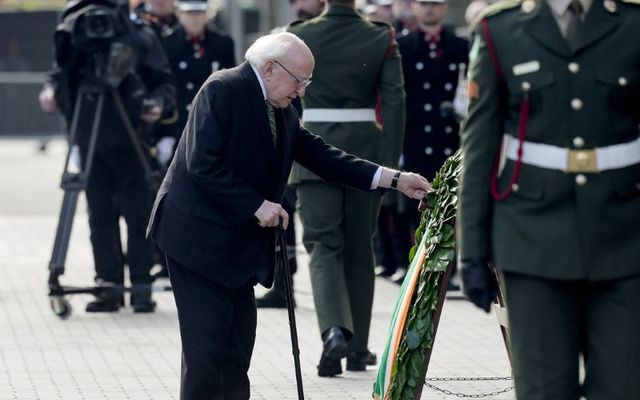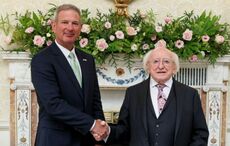President of Ireland Michael D. Higgins led a commemoration to mark the 108th anniversary of the 1916 Easter Rising in Dublin on Sunday afternoon, March 31.
Higgins was joined by Taoiseach Leo Varadkar, Tánaiste Micheál Martin, and the First Minister of Northern Ireland Michelle O'Neill at the ceremony at the General Post Office, the headquarters of the Easter Rising.
Simon Harris, who became leader of Fine Gael after Leo Varadkar's resignation last month, was also in attendance.
The ceremony marked Higgins' first public engagement since a week-long stay in hospital earlier in March after experiencing a "mild transient weakness."
Higgins laid a wreath in front of the GPO during Sunday's ceremony in honor of those who died after which a minute's silence was observed.
President and Sabina Higgins today attended the annual 1916 commemoration outside the GPO in Dublin, where President Higgins laid a wreath in memory of all those who took part, were killed and injured during the Easter Rising pic.twitter.com/VLbXJoUqPZ
— President of Ireland (@PresidentIRL) March 31, 2024
Members of the Defence Forces then lowered the national flag before Army Captain Paul Murphy read out the Proclamation of Independence.
An Eirí Amach na Cásca 2024
108 years on from the Easter Rising of 1916, Óglaigh na hÉireann proudly commemorated this seminal day in Irelands history. A poignant ceremony outside the GPO today served as a fitting tribute to a day that shaped our nation ?? pic.twitter.com/Dk3xRthkFk
— Óglaigh na hÉireann (@defenceforces) March 31, 2024
The ceremony concluded with an Air Corps flypast and prayers of remembrance, while the event also featured a brass band and a pipe band.
Sunday's events in Dublin were also the first time a Northern Ireland First Minister attended 1916 commemorations.
O'Neill was joined by her party colleague Mary Lou McDonald, the President of Sinn Féin.
Beannachtaí na Cásca oraibh. Happy Easter everyone. A season of renewal and hope.
I’m at the GPO 1916 Easter commemoration to honour Ireland’s patriot dead and the ideals of the Proclamation of the Irish Republic.
Our work is in progress, a new Ireland that unites everyone who… pic.twitter.com/2bqwWpIFUZ
— Michelle O’Neill (@moneillsf) March 31, 2024

Love Irish history? Share your favorite stories with other history buffs in the IrishCentral History Facebook group.
The 1916 Rising, which began on Easter Monday, April 24, 1916, was a transformative moment in the struggle for Irish independence.
Irish rebels took over several strategically important buildings throughout Dublin and proclaimed an Irish Republic, but the rebellion was quickly quelled, with Patrick Pearse issuing an order for all companies to surrender on April 29.
The rebels were initially deeply unpopular among the Irish public, mainly due to the high number of civilian casualties suffered during the Rising.
However, public opinion began to turn following the swift execution of 16 rebel leaders in May 1916, particularly the execution of James Connolly, who faced a firing squad tied to a chair after being mortally wounded during the conflict.
Public opinion turned so drastically that General John Maxwell commuted all remaining death sentences to penal servitude, but anti-English sentiment had already reached a fever pitch.
Thus, the 1916 Rising set the wheels in motion for the Irish War of Independence, which began in 1919 and eventually led to Ireland's independence from Britain.
A separate commemoration to honor the 16 leaders executed in May 1916 will take place at their gravesite in Arbor Hill in May.




Comments